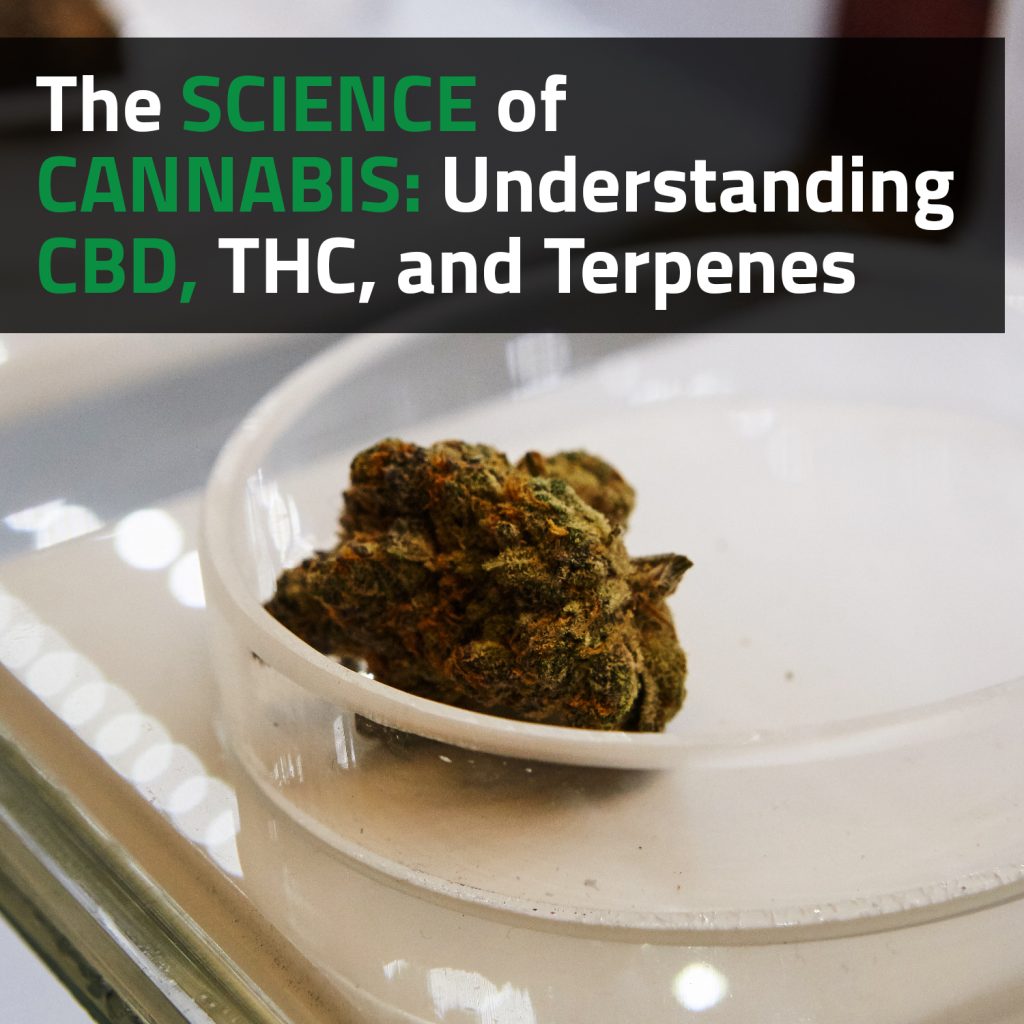Cannabis has been used for centuries for medicinal and recreational purposes. With the growing interest in the therapeutic potential of cannabis, scientists have been delving deeper into the chemistry of this plant. Cannabis contains over 100 different compounds, including cannabinoids, terpenes, and flavonoids, each with unique properties that contribute to the plant’s effects. Understanding how these compounds interact with the body can provide valuable insights into the medical benefits and risks of cannabis use.
What Is Cannabis?
Cannabis is a plant species that belongs to the Cannabaceae family. It is a dioecious plant, meaning that it has separate male and female plants. The plant’s most well-known species are Cannabis sativa, Cannabis indica, and Cannabis ruderalis.
The cannabis plant contains numerous chemical compounds, including cannabinoids, terpenes, and flavonoids. You cannot talk about cannabis without mentioning and explaining CBD and THC, these are the two most studied and well-known cannabinoids. THC is the primary psychoactive compound responsible for the euphoric effects or “high” associated with cannabis use, while CBD is non-psychoactive and has been shown to have potential therapeutic benefits.
CBD: Cannabidiol
CBD, or cannabidiol, interacts directly with the body’s endocannabinoid system (ECS). CBD is believed to have therapeutic benefits due to its ability to modulate the activity of the ECS, potentially reducing inflammation, pain, anxiety, and depression.
CBD is available in a variety of forms, including oils, capsules, gummies, and topical creams. CBD oil is one of the most popular forms of CBD and is typically taken orally. The dosage and effects of CBD can vary depending on the individual, the form of CBD used, and the method of consumption.
THC: Tetrahydrocannabinol
THC, or tetrahydrocannabinol, is the primary psychoactive compound found in the cannabis plant. THC is responsible for producing the euphoric or “high” effect associated with cannabis use.
THC works by binding to cannabinoid receptors in the brain, which are part of the endocannabinoid system (ECS). By binding to these receptors, THC can alter the functioning of the ECS and produce a range of effects on the body and mind.
Cannabis research and studies has shown that THC has potential therapeutic benefits for a variety of conditions, including chronic pain, muscle spasms, and nausea. THC has also been shown to have anti-inflammatory, analgesic, and neuroprotective properties. However, the psychoactive effects of THC can make it difficult for some individuals to use it as a medication.
THC is available in a variety of forms, including dried flower, oils, tinctures, edibles, and capsules. The dosage and effects of THC can vary depending on the individual, the form of THC used, and the method of consumption.
Terpenes: Aromatics In Cannabis
Understanding terpenes can be helpful as a cannabis user, so let’s break it down. Terpenes are a diverse group of aromatic compounds found in many plants. Terpenes are responsible for the distinctive aroma and flavour of different cannabis strains, and they are also believed to have therapeutic properties.
Terpenes interact with the body’s endocannabinoid system (ECS) and can modulate the effects of cannabinoids, including THC and CBD. For example, some terpenes may enhance the psychoactive effects of THC, while others may mitigate them. Terpenes may also have their own therapeutic properties, such as anti-inflammatory, analgesic, and anxiolytic effects.
There are over 100 terpenes identified in cannabis, and each strain can have a unique combination and concentration of terpenes. Some common terpenes found in cannabis include:
- Myrcene: The most common terpene in cannabis, myrcene has a musky, earthy aroma and is believed to have sedative and analgesic properties. It may also enhance the psychoactive effects of THC
- Limonene: Found in citrus fruits and some cannabis strains, limonene has a citrusy aroma and is believed to have anti-inflammatory, antidepressant, and anxiolytic properties
- Pinene: Found in pine needles and some cannabis strains, pinene has a piney aroma and is believed to have bronchodilatory, anti-inflammatory, and neuroprotective properties
- Linalool: Found in lavender and some cannabis strains, linalool has a floral aroma and is believed to have sedative and anxiolytic properties
Terpenes can be found in cannabis products such as oils, concentrates, and flowers. They can also be extracted and used in other products, such as aromatherapy oils, perfumes, and skincare products.
Entourage Effect: Combining CBD, THC, And Terpenes
Now let’s dive a bit into cannabis science, starting with the entourage effect. The entourage effect is a term used to describe the synergistic relationship between cannabinoids, such as THC and CBD, and other compounds found in cannabis. When these compounds are combined, they may produce a greater therapeutic effect than any one compound alone.
For example, THC and CBD may have different therapeutic properties when used alone, but when used together, they may enhance each other’s effects. Additionally, terpenes may interact with cannabinoids and other compounds to modulate their effects, leading to a more complex and nuanced effect on the body and mind.
Research has suggested that the entourage effect may be responsible for some of the therapeutic benefits of cannabis. For example, a study published in the Journal of Pain found that a cannabis extract containing both THC and CBD was more effective at reducing chronic pain than either compound alone. Other studies have suggested that specific terpenes may enhance the therapeutic properties of cannabinoids and contribute to the entourage effect.
The entourage effect has implications for the use of cannabis as a medicine. Rather than isolating individual compounds, some researchers, and healthcare providers advocate for the use of whole-plant cannabis extracts that contain a diverse range of cannabinoids, terpenes, and other compounds. By using whole-plant extracts, patients may be able to benefit from the synergistic effects of the entourage effect and achieve greater therapeutic outcomes.
Medical Benefits Of Cannabis
Cannabis has been used for medicinal purposes for thousands of years, and recent research has suggested that it may have potential therapeutic benefits for a range of health conditions.
Some of the medical benefits of cannabis include:
- Pain relief: Cannabis has been shown to be effective at reducing chronic pain, including neuropathic pain, which is often difficult to treat with conventional medications
- Anti-inflammatory effects: Cannabis may have anti-inflammatory effects, making it potentially useful for conditions such as arthritis, Crohn’s disease, and multiple sclerosis
- Anxiety and depression: Some studies have suggested that cannabis may have anxiolytic and antidepressant properties, making it potentially useful for treating anxiety disorders and depression
- Nausea and vomiting: Cannabis may be effective at reducing nausea and vomiting associated with chemotherapy and other medical treatments
- Neuroprotective properties: Cannabis may have neuroprotective properties, which could potentially make it useful for treating conditions such as Alzheimer’s disease and Parkinson’s disease
- Epilepsy: Cannabis has been shown to be effective at reducing seizures in some forms of epilepsy, leading to the development of cannabis-based medications for this condition
- Appetite stimulation: Cannabis may stimulate appetite in people with conditions such as HIV/AIDS and cancer, who may experience loss of appetite and weight loss
The study of cannabis and its compounds, including CBD, THC, and terpenes, is a rapidly growing field with many exciting possibilities. As we continue to learn more about the chemistry of cannabis and how it interacts with the human body, we may uncover new therapeutic benefits and potential uses for this plant. With a deeper understanding of the science of cannabis and its compounds, we may be able to unlock new ways to improve health and wellbeing for people around the world.










